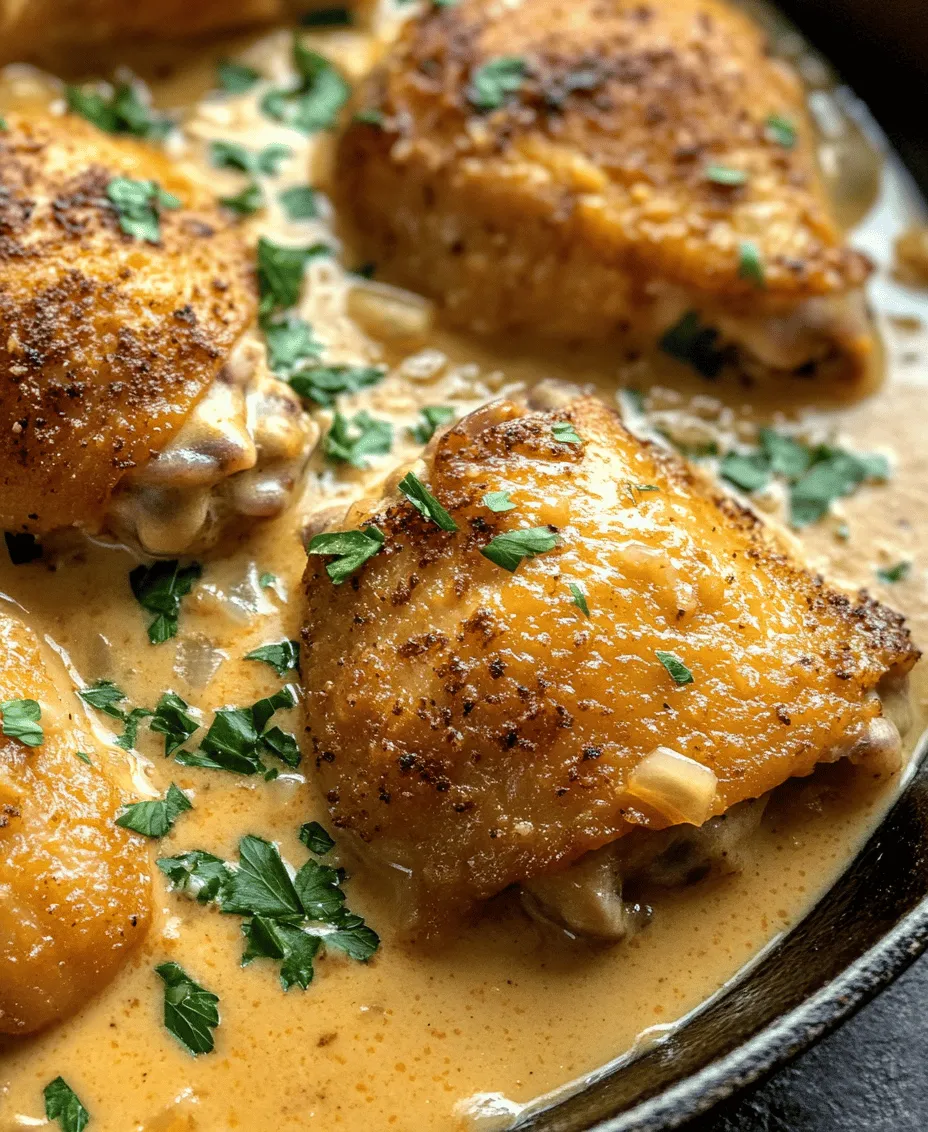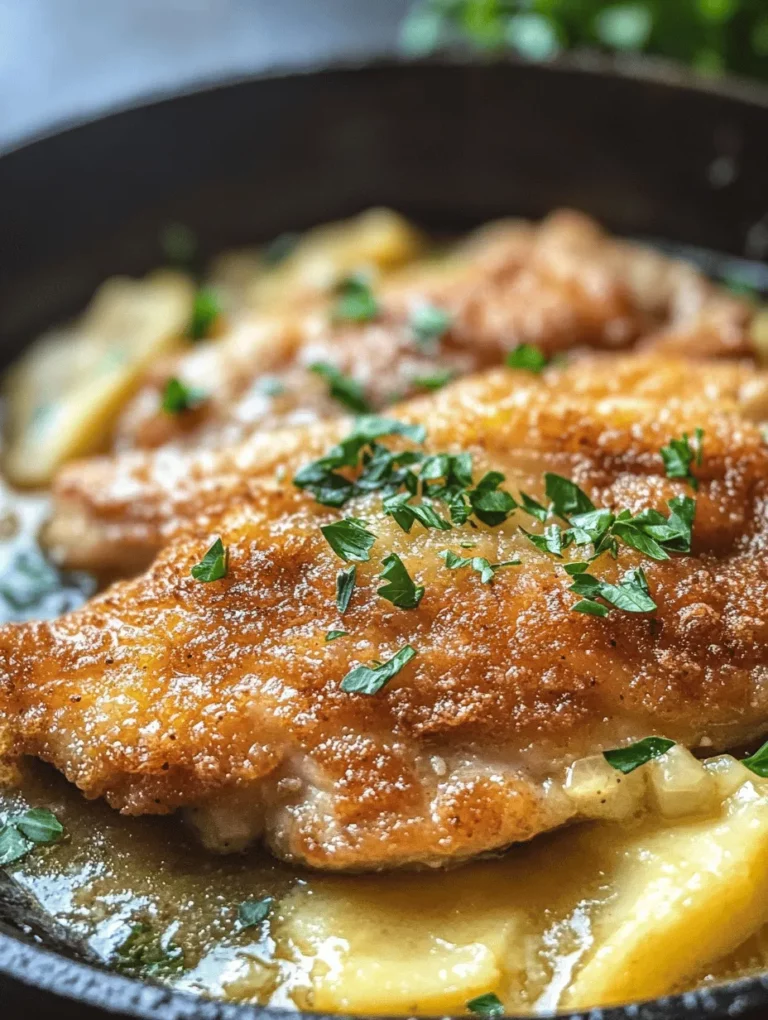In the world of home cooking, few dishes can rival the comforting appeal of Crispy Skillet Chicken with Luscious Pan Gravy. This mouthwatering recipe perfectly balances the crispy texture of seared chicken thighs with a rich, velvety gravy that elevates the dish to a new level of comfort food. Whether you’re cooking for a weeknight dinner or a special gathering, this chicken dish is sure to impress. Its simplicity combined with its deep flavors makes it a favorite among both novice cooks and seasoned chefs alike.
This recipe invites you to experience the joy of cooking with basic yet quality ingredients, and it’s rooted in traditional cooking techniques that have stood the test of time. As we journey through this culinary adventure, we will explore the intricacies of making this delightful recipe, including preparation tips, cooking techniques, and serving suggestions.
Understanding the Ingredients
Exploring the Core Components of the Dish
To create the perfect Crispy Skillet Chicken with Luscious Pan Gravy, it’s essential to understand the various ingredients that contribute to its flavor and texture. Each component plays a vital role, and selecting the right ones can make all the difference.
Overview of Chicken Thighs: Why Bone-in, Skin-on?
When it comes to chicken, the choice of cuts can significantly affect the outcome of your dish. For this recipe, bone-in, skin-on chicken thighs are recommended. Here’s why:
– Flavor: Chicken thighs are known for their rich, robust flavor, which often surpasses that of chicken breast. The bone adds depth to the taste, while the skin, when cooked properly, provides a delicious crispy texture.
– Moisture: Chicken thighs contain more fat than chicken breasts, making them less likely to dry out during cooking. This results in tender, juicy meat that pairs perfectly with the creamy gravy.
– Cooking Time: The bone helps to insulate the meat, allowing it to cook evenly without becoming overdone. This characteristic is especially beneficial when searing and then simmering in the skillet.
Seasoning Essentials: The Role of Salt, Pepper, Garlic Powder, Paprika, and Thyme
The right seasoning is crucial for elevating your chicken dish from simple to spectacular. Here’s a breakdown of the essential seasonings you’ll use:
– Salt: A fundamental seasoning that enhances the natural flavors of the chicken. It is important to season generously, as the skin can absorb the salt, leading to a well-seasoned dish.
– Pepper: Freshly ground black pepper adds a mild heat and depth to the chicken. It complements the other seasonings without overpowering them.
– Garlic Powder: This ingredient infuses the chicken with a savory aroma and flavor. It’s convenient and provides a consistent garlic flavor without the need for fresh cloves.
– Paprika: Sweet or smoked paprika adds a hint of sweetness and a beautiful color to the chicken skin. Its subtle complexity enhances the overall flavor profile.
– Thyme: Fresh or dried thyme brings an earthy, aromatic note that pairs beautifully with the savory aspects of the dish. It’s an excellent herb to incorporate into the seasoning mix.
The Importance of Olive Oil in Achieving Crispy Skin
Using a high-quality olive oil is vital for achieving that coveted crispy skin. Olive oil has a high smoke point, making it ideal for searing chicken. Here are a few benefits of using olive oil:
– Flavor: Olive oil adds a distinct flavor that complements the chicken and enhances the overall taste of the dish.
– Crispiness: A good amount of olive oil helps to create a barrier between the chicken skin and the pan, promoting even browning and crispiness.
– Health Benefits: Olive oil is known for its heart-healthy properties, making it a healthier fat choice compared to butter or margarine.
Gravy Ingredients: Chicken Broth, Heavy Cream, Flour, and Worcestershire Sauce
The luscious pan gravy is what truly ties this dish together, and it’s made with just a few simple ingredients:
– Chicken Broth: The base of the gravy, chicken broth adds depth and richness. It’s best to use homemade or high-quality store-bought broth for optimal flavor.
– Heavy Cream: This ingredient brings a luxurious creaminess and helps to thicken the gravy. It adds a velvety texture that coats the chicken beautifully.
– Flour: Used as a thickening agent, flour helps to create a smooth, luscious gravy. It’s essential to cook the flour in the skillet after the chicken to eliminate any raw taste.
– Worcestershire Sauce: A dash of Worcestershire sauce adds umami and complexity to the gravy. Its tangy flavor enhances the overall richness, making every bite irresistible.
Preparing the Chicken
Essential Steps for Perfectly Seasoned Chicken
Now that we’ve explored the ingredients, let’s dive into the essential steps to prepare the chicken properly. The way you prepare the chicken significantly impacts the flavor and texture of the final dish.
The Importance of Drying the Chicken
Before seasoning, it’s crucial to dry the chicken thoroughly. Patting the chicken skin with paper towels removes excess moisture, which can prevent proper browning. Here’s why this step matters:
– Crispiness: A dry surface ensures that the skin crisps up beautifully when seared. Moisture on the skin can result in steaming rather than searing.
– Flavor: Removing excess moisture allows the seasonings to adhere better to the chicken, resulting in a more flavorful bite.
How Long to Marinate for Optimal Flavor
For optimal flavor, it’s advisable to marinate the chicken for at least 30 minutes before cooking. Here are some tips for effective marination:
– Timing: While a short marination is beneficial, longer marination (up to 24 hours) allows the flavors to penetrate deeper into the meat. If you have time, consider marinating overnight in the refrigerator.
– Covering: Always cover the chicken while it marinates, whether in a bowl or a resealable bag, to prevent contamination and keep it from drying out.
– Room Temperature: Prior to cooking, let the marinated chicken sit at room temperature for about 15-20 minutes. This ensures even cooking and prevents the meat from being shocked by the heat.
Seasoning Techniques to Enhance Taste
Seasoning is an art that can make or break your dish. Here are some effective techniques to ensure your chicken is perfectly seasoned:
– Even Distribution: Sprinkle the seasoning mixture evenly over both sides of the chicken. This ensures that every bite is flavorful.
– Massage the Seasonings: Take a moment to rub the seasonings into the chicken. This not only helps the flavors to penetrate but also promotes an even coating.
– Let It Rest: After seasoning, allow the chicken to rest for a few minutes before cooking. This helps the salt to draw moisture into the meat, enhancing its juiciness.
Cooking Techniques
Mastering the Art of Skillet Cooking
Cooking chicken in a skillet is a straightforward method that yields delicious results. Here are some essential tips for mastering skillet cooking.
Choosing the Right Skillet for Searing
The type of skillet you use plays a significant role in how well the chicken cooks. Here are some recommendations:
– Cast Iron Skillet: A cast iron skillet is ideal for searing chicken due to its excellent heat retention and distribution. It creates a perfect crust on the chicken skin.
– Stainless Steel Skillet: If you don’t have cast iron, a heavy-bottom stainless steel skillet is a good alternative. It also provides even heating and allows for fond creation for the gravy.
– Avoid Nonstick: While nonstick pans are great for some recipes, they don’t provide the same searing quality necessary for achieving crispy skin.
The Science Behind Crispy Skin: Heat Management and Timing
Achieving crispy skin is all about managing heat and timing. Here are some key points to keep in mind:
– Preheat the Skillet: Before adding the chicken, ensure the skillet is adequately preheated. A hot skillet is crucial for achieving a good sear.
– Don’t Crowd the Pan: Cooking too many pieces of chicken at once can lower the skillet’s temperature, resulting in soggy skin. Cook in batches if necessary.
– Cooking Time: Typically, chicken thighs will need about 6-8 minutes on the first side and 4-6 minutes on the other side. Use a meat thermometer to ensure the internal temperature reaches 165°F for safe consumption.
Understanding Internal Temperature for Juicy Chicken
The key to juicy chicken is understanding the importance of internal temperature. Here’s what you need to know:
– Using a Meat Thermometer: Invest in a reliable meat thermometer to accurately check the internal temperature. Insert it into the thickest part of the thigh, avoiding the bone.
– Carryover Cooking: Keep in mind that chicken continues to cook after being removed from the heat, known as carryover cooking. Remove it from the skillet when it reaches about 160°F, allowing it to rest to reach the safe temperature.
– Resting Time: Once cooked, let the chicken rest for about 5-10 minutes before slicing. This allows the juices to redistribute, ensuring a moist and tender bite.
As we continue to explore this delightful recipe, you’ll discover how to combine these steps into a harmonious dinner that is both satisfying and impressive. Stay tuned for the next section, where we’ll delve into making the luscious pan gravy that will elevate your Crispy Skillet Chicken to new heights of flavor and indulgence.

Making the Gravy
Creating a luscious and flavorful sauce is the heart of the Crispy Skillet Chicken dish. The rich pan gravy enhances the savory flavors of the chicken, making every bite a delightful experience. Let’s dive into the steps for preparing this mouthwatering sauce.
The Process of Sautéing Onions and Garlic
To start, ensure you have all your ingredients ready for the gravy. You will need:
– 1 medium onion, finely chopped
– 4 cloves of garlic, minced
– 2 tablespoons olive oil or the drippings from the skillet
– Salt and pepper to taste
Once your chicken has been cooked and removed from the skillet, retain the drippings; they are packed with flavor. Place the skillet back on medium heat, allowing the drippings to warm. Add the chopped onions to the skillet, sautéing them until they become translucent, about 3-4 minutes. Stir occasionally to prevent burning.
Next, add the minced garlic to the skillet. Sauté for an additional minute, just until fragrant. Be careful not to let the garlic brown too much, as it can turn bitter. The combination of sautéed onions and garlic lays a robust flavor foundation for your gravy.
Crafting the Roux: Importance of Flour in Gravy
The next step in making the gravy is to create a roux, which serves as a thickening agent for the sauce. Here’s what you need:
– 2 tablespoons all-purpose flour
Sprinkle the flour over the sautéed onions and garlic, stirring continuously to incorporate. Cook the flour for about 1-2 minutes, allowing it to absorb the fat and moisture while developing a light golden color. This step is crucial as it removes the raw flour taste and adds depth to the gravy.
Step-by-Step Guide to Incorporating Chicken Broth and Cream
Once your roux is ready, it’s time to introduce the liquids that will transform it into a luscious gravy. You’ll need:
– 1 cup chicken broth (low-sodium is preferred)
– 1/2 cup heavy cream
Slowly pour in the chicken broth while whisking vigorously to prevent lumps. The broth will help deglaze the skillet, lifting the flavorful bits stuck to the bottom. Continue whisking until the mixture is smooth and begins to thicken.
After the broth is well incorporated, add the heavy cream. This addition will give your gravy a rich, silky texture. Continue to whisk and bring the mixture to a gentle simmer. Allow it to cook for about 5-7 minutes, or until it reaches your desired consistency. If it becomes too thick, you can easily thin it out with a bit more broth or water.
Achieving the Perfect Consistency: Tips for Thickening
If you find your gravy is not thickening as much as you’d like, don’t worry! Here are some tips to achieve the perfect consistency:
1. Simmer Longer: Allow the gravy to simmer for a few more minutes. The longer it cooks, the more it will reduce and thicken.
2. Add More Roux: If the gravy is still too thin after simmering, create a little more roux by mixing equal parts flour and fat (butter or oil) in a separate pan, then whisk it into the gravy.
3. Cornstarch Slurry: As a quick fix, you can mix a tablespoon of cornstarch with cold water to create a slurry. Stir this into the simmering gravy; it will thicken almost instantly.
4. Taste and Adjust: Don’t forget to taste your gravy! You may want to adjust the seasoning with salt and pepper.
Once your gravy has reached the perfect consistency, it’s ready for the next step.
Combining and Serving
Bringing the dish together is the final touch that elevates your Crispy Skillet Chicken with Pan Gravy.
How to Return the Chicken to the Gravy for Maximum Flavor Absorption
To ensure your chicken is coated in the delicious gravy, return the crispy chicken thighs to the skillet with the gravy. Nestle them gently into the sauce, spooning some gravy over the top. Let the chicken simmer in the gravy for an additional 5 minutes on low heat. This step allows the chicken to absorb the rich flavors of the gravy while keeping its crispy texture.
Presentation Tips: Garnishing with Fresh Parsley
Presentation is key to a delightful dining experience. Once the chicken is nestled in the gravy, consider garnishing the dish with freshly chopped parsley. This not only adds a pop of color but also a fresh flavor that complements the richness of the gravy. Serve the chicken on a large platter with the gravy drizzled over it for an appealing presentation.
Ideal Side Dishes to Accompany the Chicken
To make your meal complete, pair your Crispy Skillet Chicken with suitable side dishes. Here are some fantastic options:
1. Mashed Potatoes: Creamy mashed potatoes are a classic pairing, perfect for soaking up the luscious gravy.
2. Roasted Vegetables: A medley of roasted carrots, Brussels sprouts, and potatoes adds both flavor and nutrition.
3. Rice Pilaf: Fluffy rice pilaf provides a light contrast and absorbs the flavors of the gravy nicely.
4. Green Beans: Steamed or sautéed green beans add a fresh crunch to the meal, balancing the richness of the chicken.
Nutritional Highlights
Analyzing the nutritional value of this dish can provide insight into its health benefits and caloric content.
Breakdown of Ingredients: Calories, Proteins, and Fats
When prepared as suggested, a serving of Crispy Skillet Chicken with Luscious Pan Gravy typically contains:
– Calories: Approximately 450-500 calories per serving
– Proteins: Around 30 grams of protein, thanks to the chicken
– Fats: Roughly 30 grams of fat, primarily from the chicken skin and cream
These values can vary based on the specific ingredients used and portion sizes.
Benefits of Using Bone-in, Skin-on Chicken Thighs
Using bone-in, skin-on chicken thighs provides several benefits:
– Flavor: The skin adds flavor and richness to the dish, while the bones contribute to a more succulent texture.
– Moisture: The fat in the skin helps keep the chicken moist during cooking, preventing it from drying out.
– Nutritional Value: Chicken thighs are generally more affordable than breasts and provide a higher fat content that can help with satiety.
The Role of Cream and Broth in Comfort Foods
The combination of cream and chicken broth in this dish not only enhances flavor but also contributes to comfort food status. Cream adds a luxurious texture, while broth infuses the dish with savory depth. Together, they create a harmonious balance that is satisfying and hearty, making this dish ideal for family dinners or special occasions.
Conclusion
Crispy Skillet Chicken with Luscious Pan Gravy is more than just a meal; it’s a celebration of flavors and textures that can transform any dinner into a memorable occasion. By following the steps outlined in this article, you can confidently create a dish that not only satisfies your taste buds but also showcases your culinary skills. Enjoy the process of cooking, and relish in the delicious results that await you at the dinner table. This dish is sure to become a favorite in your household, perfect for gathering loved ones and sharing stories over a comforting meal. So gather your ingredients, fire up the skillet, and prepare to impress!

